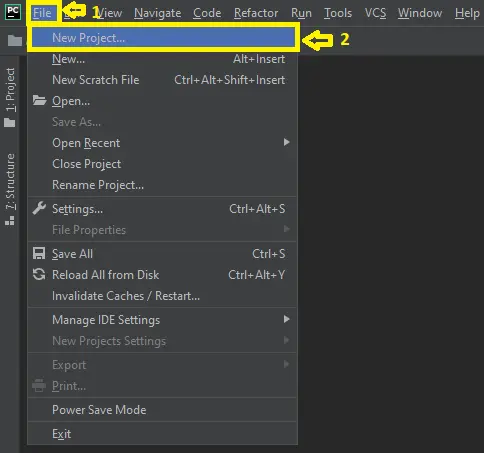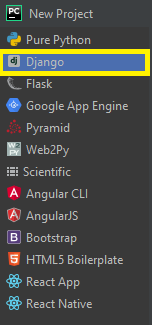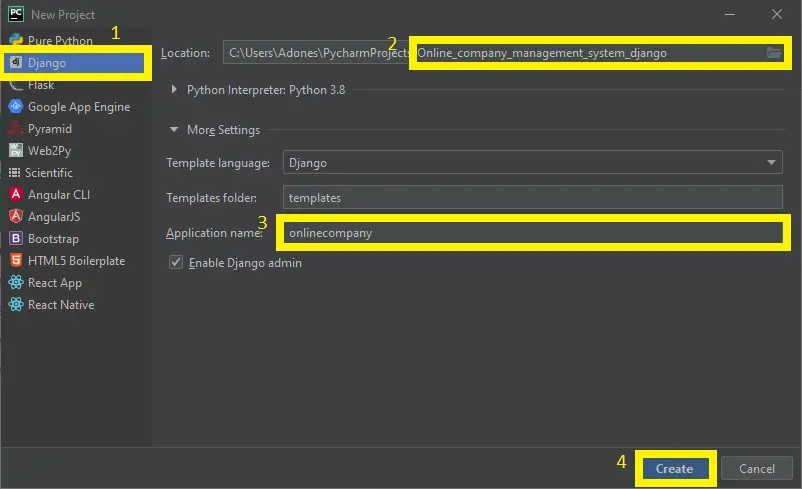Online Company Management System Project in Django with Source Code
This Online Company Management System Project in Django created based on python, Django, and MYSQL Database.
The Online Company Management System basically helps a company in managing its activities like organizing meetings, assigning tasks to employees , project team management, organizing the work, reviewing the work of employees, budgeting the projects , calculating the profits etc.
A Online Company Management System in Django is an easy project for beginners to learn how to build a web-based python Django project.
We will provide you with the complete source code and database for the python project so that you can easily install it on your machine and learn how to program in Python Django.
To start creating a Online Company Management System Project in Python Django, makes sure that you have PyCharm Professional IDE Installed in your computer.
This Online Company Management System in Django Framework, Also includes a Download Source Code for free, just find the downloadable source code below and click download now.
Admin Features: Online Company Management System Project in Django
- Employees should be assigned to the work by the administrator.
- Create a calendar to keep track of key events, schedule meetings, and organize them.
- The admin can Track the working hours of employees.
- The administrator can group the employee according to their department.
- Admin can divide the employee into teams based on the project on which they are engaged.
- Admin can Distribute the assignment across various divisions.
- Within the department group, The admin make a To-Do list and assign different tasks to different members.
- The admin can Assign project teams to the project.
- Administrator can Create a calendar to keep track of key events, schedule meetings, and organize them.
- The admin can allow the project manager to keep an eye on the progress of the project team.
- Administrator can Allow the department head to keep an eye on how the other members of the department are doing.
- The admin can set schedule tasks, set deadlines, organize meetings, and alert forthcoming events such as project evaluations and client meetings, create a calendar within the project team/department group.
- The admin can Create a Message Board within the project team/department group that allows project members to keep track of the project’s progress, make notifications about project changes, and present problem-solving ideas.
- Admin can Create an online cloud for the group to share documents and files, keep several versions of the project, and organize reference materials, among other things.
| About Project | Project Details | Definition |
|---|---|---|
| Project Name | Online Company Management System Project in Django | A Company Management System (CMS) is a set of rules, practices, procedures, and processes that are utilized in the development and implementation of strategies, as well as other related management activities. |
| Python version (Recommended) | 3.8 Version | Python 3.8 introduces some new syntax to the language, as well as a few small modifications to existing behavior and, most importantly, a slew of performance improvements, following in the footsteps of the previous 3.7 version. |
| Programming Language Used | Python Django Language | Django is a high-level Python web framework for building safe and maintainable websites quickly. Django is a web framework built by experienced developers that takes care of a lot of the heavy lifting so you can focus on developing your app instead of reinventing the wheel. |
| Developer Name | itsourcecode.com | Free projects containing source code in Java, PHP, Python, Django, VB.Net, Visual Basic, C, C++, C#, Javascript, and other languages are available on this website. |
| IDE Tool (Recommended) | Sublime, Visual Studio, PyCharm | Sublime Text is a source code editor that is available for purchase. It comes with built-in support for a variety of programming and markup languages. Plugins, which are often community-built and maintained under free-software licenses, allow users to extend the functionality of the system. Sublime Text has a Python API to help with plugins. |
| Project Type | Web Application | A web application, unlike computer-based software programs that operate locally on the device’s operating system, is application software that runs on a web server. The user uses a web browser with an active network connection to access web apps. |
| Database | SQLite | SQLite is a programming language that is used to create embedded software for devices such as televisions, cell phones, and cameras. It can handle HTTP requests with low to medium traffic. SQLite has the ability to compress files into smaller bundles with less metadata. SQLite is a temporary dataset that is used within an application to process data. |
Online Company Management System Project in Django Steps on How to Create a Project
Time needed: 5 minutes
Here are the steps how to create a Online Company Management System Project in Django with Source Code.
- Step 1: Open file.
First , open “pycharm professional” after that click “file” and click “new project”.

- Step 2: Choose Django.
Next, after click “new project“, choose “Django” and click.

- Step 3: Select file location.
Then, select a file location wherever you want.

- Step 4: Create application name.
After that, name your application.

- Step 5: Click create.
Lastly, finish creating project by clicking “create” button.

- Step 6: Start Coding.
Finally, we will now start adding functionality to our Django Framework by adding some functional codes.
Functionality and Codes of the Online Company Management System Project in Django with Source Code
- Create template for the homepage in Online Company Management System Project in Django.
In this section, we will learn on how create a templates for the homepage. To start with, add the following code in your homepage.html under the folder of /templates/.
{% load static %}
<!DOCTYPE html>
<html>
<head>
<meta charset="utf-8">
<meta name="viewport" content="width=device-width, initial-scale=1.0">
<meta http-equiv="X-UA-Compatible" content="IE=edge">
<title>dashboard</title>
<!-- Bootstrap CSS CDN -->
<link rel="stylesheet" href="https://stackpath.bootstrapcdn.com/bootstrap/4.1.0/css/bootstrap.min.css" integrity="sha384-9gVQ4dYFwwWSjIDZnLEWnxCjeSWFphJiwGPXr1jddIhOegiu1FwO5qRGvFXOdJZ4" crossorigin="anonymous">
<!-- Our Custom CSS -->
<link rel="stylesheet" href="{% static 'css/style.css' %}">
<script src="https://ajax.googleapis.com/ajax/libs/jquery/3.3.1/jquery.min.js"></script>
<script src="https://cdnjs.cloudflare.com/ajax/libs/popper.js/1.14.3/umd/popper.min.js"></script>
<script src="https://maxcdn.bootstrapcdn.com/bootstrap/4.1.3/js/bootstrap.min.js"></script>
<!-- Font Awesome JS -->
<script defer src="https://use.fontawesome.com/releases/v5.0.13/js/solid.js" integrity="sha384-tzzSw1/Vo+0N5UhStP3bvwWPq+uvzCMfrN1fEFe+xBmv1C/AtVX5K0uZtmcHitFZ" crossorigin="anonymous"></script>
<script defer src="https://use.fontawesome.com/releases/v5.0.13/js/fontawesome.js" integrity="sha384-6OIrr52G08NpOFSZdxxz1xdNSndlD4vdcf/q2myIUVO0VsqaGHJsB0RaBE01VTOY" crossorigin="anonymous"></script>
</head>
<body style="background-image:url('{% static 'images/13390.jpg' %}');background-size:cover; background-repeat:no-repeat;">
<nav class="navbar navbar-expand-lg navbar-dark bg-dark fixed-top">
<div class="navbar-header">
<a class="navbar-brand" href="/">Company Management System</a>
</div>
<button class="navbar-toggler" type="button" data-toggle="collapse" data-target="#navbarSupportedContent" aria-controls="navbarSupportedContent" aria-expanded="false" aria-label="Toggle navigation">
<span class="navbar-toggler-icon"></span>
</button>
<div class="collapse navbar-collapse" id="navbar">
{% if user.is_authenticated %}
<ul class="navbar-nav mr-auto">
<li><a class="nav-link" href="/accounts/">Home <span class="fa fa-home"></span></a></li>
</ul>
<ul class="navbar-nav ml-auto">
<li><a class="nav-link" href='/accounts/profile'>Profile <span class="fa fa-user"></span></a></li>
<li><a class="nav-link" href='/accounts/logout'>Logout <span class="fa fa-sign-out-alt"></span></a></li>
</ul>
{% else %}
<ul class="navbar-nav">
<li><a class="nav-link" href='/accounts/reset-password'>Reset Password</a></li>
</ul>
<ul class="navbar-nav ml-auto">
<li><a class="nav-link" href='/accounts/login'>Login <span class="fa fa-sign-in-alt"></span></a></li>
<li><a class="nav-link" href="/accounts/inter_reg">Register <span class="fa fa-sign-in-alt"></span></a></li>
</ul>
{% endif %}
</div>
</nav>
<br><br><br>
<div class="wrapper">
<!-- Sidebar -->
<nav id="sidebar">
<div class="sidebar-header">
<h3>{{ request.user }}</h3>
</div>
<ul class="list-unstyled components">
<li class="active">
<a href="#homeSubmenu" data-toggle="collapse" aria-expanded="false" class="dropdown-toggle">
<i class="fa fa-user"></i>
My Profile
</a>
<ul class="collapse list-unstyled" id="homeSubmenu">
<li>
<a href="{% url 'view_profile' %}">View Profile</a>
</li>
<li>
<a href="{% url 'edit_profile' %}">Edit Profile</a>
</li>
</ul>
</li>
<li>
<a href="{% url 'history:trials' %}">
<i class="fas fa-briefcase"></i>
My Recent Activity
</a>
<a href="#pageSubmenu" data-toggle="collapse" aria-expanded="false" class="dropdown-toggle">
<i class="fas fa-copy"></i>
My Task and Assignments
</a>
<ul class="collapse list-unstyled" id="pageSubmenu">
<li>
<a href="{% url 'assignments:display' %}">My Assignments</a>
</li>
<li>
<a href="{% url 'assignments:my_todo' %}">self assigned tasks</a>
</li>
</ul>
</li>
<li>
<a href="{% url 'notifications:index' %}">
<i class="fas fa-bell"></i>
Notifications
</a>
</li>
<li>
<a href="{% url 'put_calendar:index' select='1' show='1' %}">
<i class="fas fa-calendar"></i>
calendar
</a>
</li>
<li>
<a href="{% url 'clients:index' %}">
<i class="fas fa-address-book"></i>
Client List
</a>
</li>
</ul>
</nav>
<!-- Page Content -->
<div id="content">
<nav class="navbar navbar-expand-lg navbar-light bg-light">
<div class="container-fluid">
<button type="button" id="sidebarCollapse" class="btn btn-info">
<i class="fas fa-align-left"></i>
</button>
<button class="btn btn-dark d-inline-block d-lg-none ml-auto" type="button" data-toggle="collapse" data-target="#navbarSupportedContent" aria-controls="navbarSupportedContent" aria-expanded="false" aria-label="Toggle navigation">
<i class="fas fa-align-justify"></i>
</button>
</div>
<h2 class="display-4" style="font-size:50px;">Personal Dashboard</h2>
</nav>
{% block content %}
{% endblock content %}
</div>
</div>
<!-- jQuery CDN - Slim version (=without AJAX) -->
<script src="https://code.jquery.com/jquery-3.3.1.slim.min.js" integrity="sha384-q8i/X+965DzO0rT7abK41JStQIAqVgRVzpbzo5smXKp4YfRvH+8abtTE1Pi6jizo" crossorigin="anonymous"></script>
<!-- Popper.JS -->
<script src="https://cdnjs.cloudflare.com/ajax/libs/popper.js/1.14.0/umd/popper.min.js" integrity="sha384-cs/chFZiN24E4KMATLdqdvsezGxaGsi4hLGOzlXwp5UZB1LY//20VyM2taTB4QvJ" crossorigin="anonymous"></script>
<!-- Bootstrap JS -->
<script src="https://stackpath.bootstrapcdn.com/bootstrap/4.1.0/js/bootstrap.min.js" integrity="sha384-uefMccjFJAIv6A+rW+L4AHf99KvxDjWSu1z9VI8SKNVmz4sk7buKt/6v9KI65qnm" crossorigin="anonymous"></script>
<script type="text/javascript">
$(document).ready(function () {
$('#sidebarCollapse').on('click', function () {
$('#sidebar').toggleClass('active');
});
});
</script>
{% block content1 %}
{% endblock content1 %}
</body>
</html>
{% load static %}
<!DOCTYPE html>
<html>
<head>
<meta charset="utf-8">
<meta name="viewport" content="width=device-width, initial-scale=1.0">
<meta http-equiv="X-UA-Compatible" content="IE=edge">
<title>dashboard</title>
<!-- Bootstrap CSS CDN -->
<link rel="stylesheet" href="https://stackpath.bootstrapcdn.com/bootstrap/4.1.0/css/bootstrap.min.css" integrity="sha384-9gVQ4dYFwwWSjIDZnLEWnxCjeSWFphJiwGPXr1jddIhOegiu1FwO5qRGvFXOdJZ4" crossorigin="anonymous">
<!-- Our Custom CSS -->
<link rel="stylesheet" href="{% static 'css/style.css' %}">
<script src="https://ajax.googleapis.com/ajax/libs/jquery/3.3.1/jquery.min.js"></script>
<script src="https://cdnjs.cloudflare.com/ajax/libs/popper.js/1.14.3/umd/popper.min.js"></script>
<script src="https://maxcdn.bootstrapcdn.com/bootstrap/4.1.3/js/bootstrap.min.js"></script>
<!-- Font Awesome JS -->
<script defer src="https://use.fontawesome.com/releases/v5.0.13/js/solid.js" integrity="sha384-tzzSw1/Vo+0N5UhStP3bvwWPq+uvzCMfrN1fEFe+xBmv1C/AtVX5K0uZtmcHitFZ" crossorigin="anonymous"></script>
<script defer src="https://use.fontawesome.com/releases/v5.0.13/js/fontawesome.js" integrity="sha384-6OIrr52G08NpOFSZdxxz1xdNSndlD4vdcf/q2myIUVO0VsqaGHJsB0RaBE01VTOY" crossorigin="anonymous"></script>
</head>
<body style="background-image:url('{% static 'images/13390.jpg' %}');background-size:cover; background-repeat:no-repeat;">
<nav class="navbar navbar-expand-lg navbar-dark bg-dark fixed-top">
<div class="navbar-header">
<a class="navbar-brand" href="/">Company Management System</a>
</div>
<button class="navbar-toggler" type="button" data-toggle="collapse" data-target="#navbarSupportedContent" aria-controls="navbarSupportedContent" aria-expanded="false" aria-label="Toggle navigation">
<span class="navbar-toggler-icon"></span>
</button>
<div class="collapse navbar-collapse" id="navbar">
{% if user.is_authenticated %}
<ul class="navbar-nav mr-auto">
<li><a class="nav-link" href="/accounts/">Home <span class="fa fa-home"></span></a></li>
</ul>
<ul class="navbar-nav ml-auto">
<li><a class="nav-link" href='/accounts/profile'>Profile <span class="fa fa-user"></span></a></li>
<li><a class="nav-link" href='/accounts/logout'>Logout <span class="fa fa-sign-out-alt"></span></a></li>
</ul>
{% else %}
<ul class="navbar-nav">
<li><a class="nav-link" href='/accounts/reset-password'>Reset Password</a></li>
</ul>
<ul class="navbar-nav ml-auto">
<li><a class="nav-link" href='/accounts/login'>Login <span class="fa fa-sign-in-alt"></span></a></li>
<li><a class="nav-link" href="/accounts/inter_reg">Register <span class="fa fa-sign-in-alt"></span></a></li>
</ul>
{% endif %}
</div>
</nav>
<br><br><br>
<div class="wrapper">
<!-- Sidebar -->
<nav id="sidebar">
<div class="sidebar-header">
<h3>{{ request.user }}</h3>
</div>
<ul class="list-unstyled components">
<li class="active">
<a href="#homeSubmenu" data-toggle="collapse" aria-expanded="false" class="dropdown-toggle">
<i class="fa fa-user"></i>
My Profile
</a>
<ul class="collapse list-unstyled" id="homeSubmenu">
<li>
<a href="{% url 'view_profile' %}">View Profile</a>
</li>
<li>
<a href="{% url 'edit_profile' %}">Edit Profile</a>
</li>
</ul>
</li>
<li>
<a href="{% url 'history:trials' %}">
<i class="fas fa-briefcase"></i>
My Recent Activity
</a>
<a href="#pageSubmenu" data-toggle="collapse" aria-expanded="false" class="dropdown-toggle">
<i class="fas fa-copy"></i>
My Task and Assignments
</a>
<ul class="collapse list-unstyled" id="pageSubmenu">
<li>
<a href="{% url 'assignments:display' %}">My Assignments</a>
</li>
<li>
<a href="{% url 'assignments:my_todo' %}">self assigned tasks</a>
</li>
</ul>
</li>
<li>
<a href="{% url 'notifications:index' %}">
<i class="fas fa-bell"></i>
Notifications
</a>
</li>
<li>
<a href="{% url 'put_calendar:index' select='1' show='1' %}">
<i class="fas fa-calendar"></i>
calendar
</a>
</li>
<li>
<a href="{% url 'clients:index' %}">
<i class="fas fa-address-book"></i>
Client List
</a>
</li>
</ul>
</nav>
<!-- Page Content -->
<div id="content">
<nav class="navbar navbar-expand-lg navbar-light bg-light">
<div class="container-fluid">
<button type="button" id="sidebarCollapse" class="btn btn-info">
<i class="fas fa-align-left"></i>
</button>
<button class="btn btn-dark d-inline-block d-lg-none ml-auto" type="button" data-toggle="collapse" data-target="#navbarSupportedContent" aria-controls="navbarSupportedContent" aria-expanded="false" aria-label="Toggle navigation">
<i class="fas fa-align-justify"></i>
</button>
</div>
<h2 class="display-4" style="font-size:50px;">Personal Dashboard</h2>
</nav>
{% block content %}
{% endblock content %}
</div>
</div>
<!-- jQuery CDN - Slim version (=without AJAX) -->
<script src="https://code.jquery.com/jquery-3.3.1.slim.min.js" integrity="sha384-q8i/X+965DzO0rT7abK41JStQIAqVgRVzpbzo5smXKp4YfRvH+8abtTE1Pi6jizo" crossorigin="anonymous"></script>
<!-- Popper.JS -->
<script src="https://cdnjs.cloudflare.com/ajax/libs/popper.js/1.14.0/umd/popper.min.js" integrity="sha384-cs/chFZiN24E4KMATLdqdvsezGxaGsi4hLGOzlXwp5UZB1LY//20VyM2taTB4QvJ" crossorigin="anonymous"></script>
<!-- Bootstrap JS -->
<script src="https://stackpath.bootstrapcdn.com/bootstrap/4.1.0/js/bootstrap.min.js" integrity="sha384-uefMccjFJAIv6A+rW+L4AHf99KvxDjWSu1z9VI8SKNVmz4sk7buKt/6v9KI65qnm" crossorigin="anonymous"></script>
<script type="text/javascript">
$(document).ready(function () {
$('#sidebarCollapse').on('click', function () {
$('#sidebar').toggleClass('active');
});
});
</script>
{% block content1 %}
{% endblock content1 %}
</body>
</html>
- Create template for the login form in Online Company Management System Project in Django.
In this section, we will learn on how create a templates for the login form. To start with, add the following code in your login.html under the folder of /templates/.
{% extends 'base.html' %}
{% block head %}
<style>
#grad{
background-image: linear-gradient(to bottom left, #ffb2c4f2, #85d8fed1);
}
a,a:hover{
color:#005abb;
text-decoration: none;
}
.md-form{
font-size: 20px;
color: #383838;
}
</style>
<title>Login Page</title>
{% endblock %}
{% block body %}
<script type="text/javascript">
$(function(){
$("#id_username").addClass("form-control");
$("#id_password").addClass("form-control");
});
</script>
<br><br><br>
<div class="card" style="margin-left: 55px;border-radius: 15px;width: 500px;height: 520px;">
<h5 class="card-header info-color white-text text-center py-4">
<strong class="display-4" style="font-size:40px;">Log in</strong>
</h5>
<!--Card content-->
<div class="card-body px-lg-5 pt-0" id="grad" style="border-radius: 11px;">
<br><br>
<!-- Form -->
<form class="text-center" method="post" autocomplete="on">
{% csrf_token %}
<!-- Email -->
<div class="md-form" style="font-size: 20px;">
<label for="materialLoginFormEmail">username</label>
{{form.username}}
</div>
<br>
<!-- Password -->
<div class="md-form" style="font-size: 20px;">
<label for="materialLoginFormPassword">Password</label>
{{form.password}}
</div>
<div class="d-flex justify-content-around">
<div>
<!-- Remember me -->
<div class="form-check">
<input type="checkbox" class="form-check-input" id="materialLoginFormRemember">
<label class="form-check-label" for="materialLoginFormRemember">Remember me</label>
</div>
</div>
<div>
<!-- Forgot password -->
<a href="/accounts/reset-password">Forgot password?</a>
</div>
</div>
<br>
<!-- Sign in button -->
<button class="btn btn-outline-info btn-rounded btn-block my-4 waves-effect z-depth-0" type="submit">Sign in</button>
<!-- Register -->
<p>Not a member?
<a href="/accounts/inter_reg/">Register</a>
</p>
</form>
<!-- Form -->
</div>
</div>
{% endblock %}
<!-- Material form login -->
- Create template for the edit profile form in Online Company Management System Project in Django.
In this section, we will learn on how create a templates for the edit profile form. To start with, add the following code in your edit_profile.html under the folder of /templates/.
{% extends 'homepage.html' %}
{% block head %}
<title>EDIT PROFILE PAGE</title>
<style>
.form-control {
width: 40%;
}
</style>>
{% endblock %}
{% block content %}
<script type="text/javascript">
$(function () {
$("#id_email").addClass("form-control");
$("#id_first_name").addClass("form-control");
$("#id_last_name").addClass("form-control");
$("#id_phone").addClass("form-control");
$("#id_city").addClass("form-control");
});
</script>
<br><br>
<div class="card">
<div class="card-body">
<h1 class="display-4" style="font-size:35px;font-weight:400;">Edit Profile:</h1><br>
<div class="container" style="width:50%;">
<form method="post">
{% csrf_token %}
First name: {{ form.first_name }}
Last name: {{ form.last_name }}
Email: {{ form.email }}
<br>
Phone: {{ form1.phone }}
City: {{ form1.city }}
<button type="submit">Submit</button>
</form>
<br>
<a class="nav-link" href='/accounts/change-password'>
<button type="button" class="btn btn-danger">Change password</button>
</a>
</div>
</div>
</div>
{% endblock %}
Downloadable Source Code Below.
Anyway, if you want to level up your programming knowledge, especially python, try this new article I’ve made for you Best Python Projects with source code for Beginners.
But If you’re going to focus on web development using Django, you can download here from our list of Best Django Projects with source code based on real-world projects.
How To Run The Online Company Management System Project in Django?
- Step 1: Extract/unzip the file
- Step 2: Go inside the project folder, open cmd and type the following commands to install Django Framework and run the webserver:
- pip install -r requirements.txt
- python manage.py migrate
- python manage.py runserver
- Step 3: Finally, open the browser and go to http://127.0.0.1:8000/
Summary
In summary, the Online Company Management System Project in Django with Source Code can be useful to students or professional who wants to learn python programming language.
This project can also be modified to fit your personal requirements. Hope this project will help you to improve your skills. Happy Coding!
- How To Make A Point Of Sale System In Python
- Best Python Projects for Beginners
- Python MySQL Connection: Simple Python Step by Step Guide
- Python PIP Command Set-up / Fix: Step by Step Guide
- Random Password Generator in Python Projects With Source Code
- Python Range Function|Range in Python Explained with Examples
- School Management System Project In Django With Source Code
- Django Login And Registration With Source Code
- CRUD App In Django With Source Code
- Drag And Drop JavaScript With Source Code
- Todo List App Django With Source Code
Inquiries
If you have any questions or suggestions about Online Company Management System Project in Django with Source Code, please feel free to leave a comment below.




